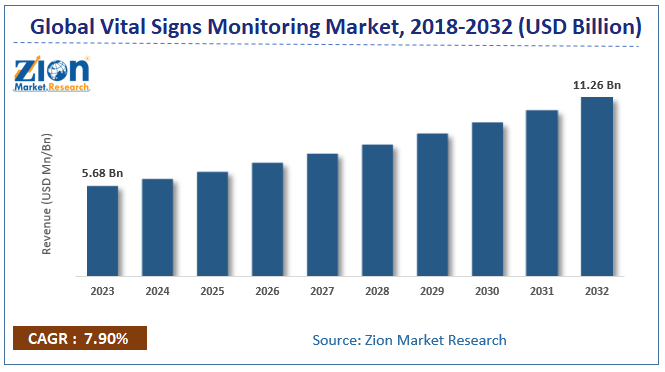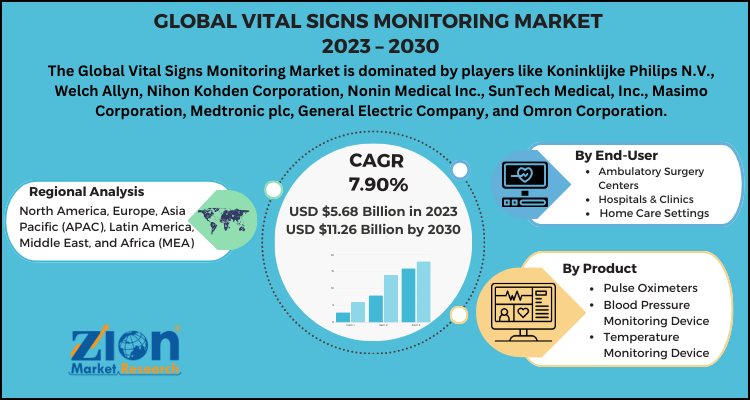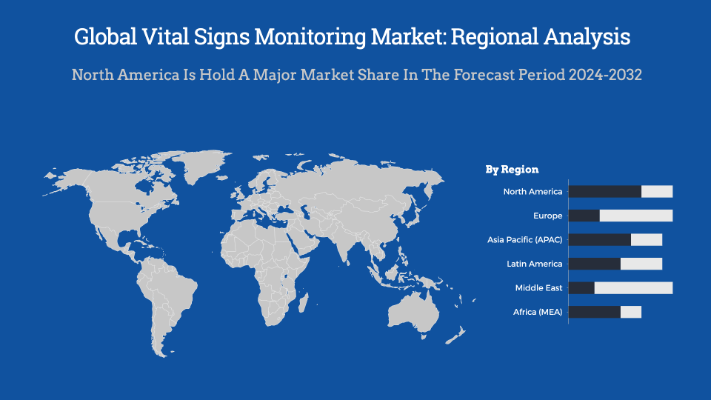Vital Signs Monitoring Market Size, Share, Trends, Growth, Forecasts, 2032

Vital Signs Monitoring Market By End-user (ambulatory surgery centers, hospitals & clinics, and home care settings), By Product (pulse oximeters, blood pressure monitoring device, and temperature monitoring device) And By Region: - Global And Regional Industry Overview, Market Intelligence, Comprehensive Analysis, Historical Data, And Forecasts, 2024-2032
| Market Size in 2023 | Market Forecast in 2032 | Growth Rate (in %) | Base Year |
|---|---|---|---|
| USD 5.68 Billion | USD 11.26 Billion | CAGR at 7.90% | 2023 |
Description
Global Vital Signs Monitoring Market: Insights
According to the report published by Zion Market Research, the global Vital Signs Monitoring Market size was valued at USD 5.68 Billion in 2023 and is predicted to reach USD 11.26 Billion by the end of 2032. The market is expected to grow with a CAGR of 7.90% during the forecast period. The report analyzes the global Vital Signs Monitoring Market’s growth drivers, restraints, and impact on demand during the forecast period. It will also help navigate and explore the arising opportunities in the Vital Signs Monitoring Market industry.
Global Vital Signs Monitoring Market: Overview
Vital signs monitoring devices execute screening of vital factors such as heart rate, blood pressure, body temperature, and respiratory rate. Additionally, this process may also include examining of several other extra signs such as urinary continence, pain, gait speed, end-tidal carbon dioxide, shortness of breath, and so on. These monitoring devices offer and capture clinically significant information regarding the health status of a patient. Moreover, verification of vital signs after and before medical procedure also reduces patient risk and decreases fault in the elucidation of clinical data.
Global Vital Signs Monitoring Market: Growth Factors
The major factors influencing the growth of the global vital signs monitoring market are cost-effective processes, rising need for portable monitoring devices, increase in the aging population, and growth in the frequency of hospital admissions. However, the unresponsiveness of few devices in specific conditions and the huge digit of market players are few factors that may impede the market growth.
Key Insights
- As per the analysis shared by our research analyst, the global Vital Signs Monitoring Market is estimated to grow annually at a CAGR of around 7.90% over the forecast period (2024-2032).
- In terms of revenue, the global Vital Signs Monitoring Market size was valued at around USD 5.68 Billion in 2023 and is projected to reach USD 11.26 Billion by 2032.
- Based on the end-user, Hospitals are the primary end-users of vital signs monitoring devices. This dominance is due to their comprehensive healthcare services, handling a diverse patient population requiring continuous and critical care monitoring. Hospitals utilize these devices extensively in various departments, including emergency rooms, intensive care units (ICUs), and during post-operative recovery. Their substantial resources and infrastructure enable the adoption of advanced monitoring technologies to ensure optimal patient outcomes.
- Based on the product, Among the various product categories, blood pressure monitors hold the largest market share. This prominence is driven by the increasing prevalence of hypertension and cardiovascular diseases globally. Continuous blood pressure monitoring is vital for early detection and management of these conditions, leading to a heightened demand for these devices across healthcare settings.
- Based on the region, Geographically, North America leads the global vital signs monitoring market. Factors contributing to this dominance include advanced healthcare infrastructure, high healthcare expenditure, and rapid adoption of innovative medical technologies. The region also faces a significant burden of chronic diseases and has a growing elderly population, further driving the demand for vital signs monitoring devices.
Vital Signs Monitoring Market: Dynamics
Key Growth Drivers
The vital signs monitoring market is experiencing significant growth, driven by the increasing prevalence of chronic diseases such as cardiovascular disorders, respiratory diseases, and diabetes. The growing geriatric population, which is more susceptible to health conditions requiring continuous monitoring, further fuels market demand. Technological advancements, including the development of wearable and remote monitoring devices, offer real-time data tracking and improve patient outcomes. Additionally, the rising adoption of telehealth services and home healthcare solutions has accelerated the need for user-friendly and portable vital signs monitoring devices. Government initiatives aimed at promoting early diagnosis and preventive healthcare also contribute to market expansion.
Restraints
Despite its growth potential, the vital signs monitoring market faces challenges such as the high cost of advanced monitoring devices and limited reimbursement policies in some regions. Concerns related to data privacy and cybersecurity in connected healthcare systems may also hinder the adoption of remote monitoring solutions. Moreover, the lack of skilled healthcare professionals to operate and interpret the data from sophisticated monitoring devices poses a restraint, particularly in low- and middle-income countries. Device accuracy and reliability issues, especially with low-cost or counterfeit products, further limit market growth.
Opportunities
The increasing integration of artificial intelligence (AI) and machine learning (ML) in vital signs monitoring devices presents significant growth opportunities. AI-powered systems can predict potential health issues by analyzing real-time data, leading to proactive and personalized patient care. The expansion of remote patient monitoring programs, particularly for managing chronic conditions, also opens avenues for market growth. Additionally, emerging economies with improving healthcare infrastructure offer untapped potential for manufacturers. Partnerships between healthcare providers and technology companies to develop innovative and cost-effective solutions will further drive market opportunities.
Challenges
One of the primary challenges in the vital signs monitoring market is ensuring data accuracy and device reliability across different settings. Variability in patient conditions and environmental factors can affect the accuracy of readings, leading to potential misdiagnoses. Regulatory complexities and compliance with stringent standards for medical device approvals pose additional challenges for market players. Furthermore, interoperability issues between different monitoring devices and healthcare systems can hinder seamless data exchange and limit the effectiveness of integrated healthcare solutions. Addressing the digital divide in rural and underdeveloped regions also remains a key challenge for expanding the reach of vital signs monitoring solutions.
Vital Signs Monitoring Market: Report Scope
| Report Attributes | Report Details |
|---|---|
| Report Name | Vital Signs Monitoring Market Research Report |
| Market Size in 2023 | USD 5.68 Billion |
| Market Forecast in 2032 | USD 11.26 Billion |
| Growth Rate | CAGR of 7.90% |
| Number of Pages | 196 |
| Key Companies Covered | Koninklijke Philips N.V., Welch Allyn, Nihon Kohden Corporation, Nonin Medical Inc., SunTech Medical, Inc., Masimo Corporation, Medtronic plc, General Electric Company, and Omron Corporation. The other key players in the market are A&D Company, Limited, Dragerwerk AG & Co. KGa, Smiths Group plc., Briggs Healthcare Spacelabs Healthcare, Inc., CAS Medical Systems, Inc., Contec Medical Systems Co., Ltd., and Mindray Medical International Limited. |
| Segments Covered | By End-user, By Product and By Region |
| Regions Covered | North America, Europe, Asia Pacific (APAC), Latin America, Middle East, and Africa (MEA) |
| Base Year | 2023 |
| Historical Year | 2018 to 2022 |
| Forecast Year | 2024 - 2032 |
| Customization Scope | Avail customized purchase options to meet your exact research needs. Request For Customization |
Global Vital Signs Monitoring Market: Segmentation
The global vital signs monitoring market can be segmented based on end-user, product, and region. All the segments have been analyzed based on present and future trends and the market is estimated from 2024 to 2032.
The end-user segment of the market is categorized into ambulatory surgery centers, hospitals & clinics, and home care settings.
The product segment of the market is diversified into pulse oximeters, blood pressure monitoring device, and temperature monitoring device.
- The pulse oximeters segment of the market is divided into fingertip pulse oximeters, wrist-worn pulse oximeters, table-top/bedside pulse oximeters, hand-held pulse oximeters, and pediatric pulse oximeters.
- The blood pressure monitoring device segment of the vital signs monitoring market is classified into digital blood pressure monitors, blood pressure instrument accessories, aneroid blood pressure monitors, and ambulatory blood pressure monitors.
- The temperature monitoring device segment of the market is sub-segmented into infrared thermometers, digital thermometers, and temperature strips.
The regional segment includes the current and forecast demand for North America, Europe, Asia Pacific, Latin America, and the Middle East and Africa.
Global Vital Signs Monitoring Market: Regional Analysis
The vital signs monitoring market exhibits distinct growth patterns across various regions, influenced by factors such as healthcare infrastructure, prevalence of chronic diseases, technological advancements, and demographic trends.
North America
North America holds a significant share of the vital signs monitoring market, driven by advanced healthcare infrastructure, a high prevalence of chronic diseases, and the widespread adoption of innovative technologies. The United States, in particular, leads the regional market due to its strong focus on healthcare research and development and the presence of leading medical device manufacturers.
Europe
Europe follows as a major market, with countries such as Germany, the United Kingdom, and France contributing significantly. Factors driving growth in this region include favorable government policies, increasing healthcare investments, and a rising aging population.
Asia-Pacific
The Asia-Pacific region is emerging as the fastest-growing market, fueled by rapid urbanization, rising healthcare awareness, and increasing disposable incomes. Countries like China, India, and Japan are at the forefront of this growth, supported by government initiatives to improve healthcare infrastructure and the growing popularity of wearable health technologies.
Latin America
Latin America is experiencing steady market growth, with countries like Brazil and Mexico investing in healthcare technology to address the needs of their populations. Government initiatives to enhance healthcare accessibility and affordability are driving the adoption of vital signs monitoring devices in hospitals, clinics, and home care settings.
Middle East and Africa
The Middle East and Africa region is witnessing growth driven by increasing healthcare expenditure, expanding healthcare infrastructure, and growing awareness about chronic diseases. Countries in the region are investing in telemedicine services, digital health solutions, and remote monitoring technologies to enhance healthcare access and improve patient outcomes.
Global Vital Signs Monitoring Market: Competitive Players
The prominent players in the market for vital signs monitoring devices include:
- Koninklijke Philips N.V.
- Welch Allyn
- Nihon Kohden Corporation
- Nonin Medical Inc.
- SunTech Medical, Inc.
- Masimo Corporation
- Medtronic plc
- General Electric Company
- Omron Corporation
The other key players in the market are
- A&D Company
- Limited
- Dragerwerk AG & Co. KGa
- Smiths Group plc.
- Briggs Healthcare Spacelabs Healthcare, Inc.
- CAS Medical Systems, Inc.
- Contec Medical Systems Co., Ltd.
- Mindray Medical International Limited.
The Global Vital Signs Monitoring Market is segmented as follows:
By End-user
- Ambulatory Surgery Centers
- Hospitals & Clinics
- Home Care Settings
By Product
- Pulse Oximeters
- Blood Pressure Monitoring Device
- Temperature Monitoring Device
Global Vital Signs Monitoring Market: Regional Segment Analysis
- North America
- U.S.
- Europe
- UK
- France
- Germany
- Asia Pacific
- China
- Japan
- India
- Latin America
- Brazil
- The Middle East and Africa
What Report Provides
- Full in-depth analysis of the parent market
- Important changes in market dynamics
- Segmentation details of the market
- Former, on-going, and projected market analysis in terms of volume and value
- Assessment of niche industry developments
- Market share analysis
- Key strategies of major players
- Emerging segments and regional markets
- Testimonials to companies in order to fortify their foothold in the market.
Table Of Content
FrequentlyAsked Questions
Vital signs monitoring devices execute screening of vital factors such as heart rate, blood pressure, body temperature, and respiratory rate. Additionally, this process may also include examining of several other extra signs such as urinary continence, pain, gait speed, end-tidal carbon dioxide, shortness of breath, and so on. These monitoring devices offer and capture clinically significant information regarding the health status of a patient.
The Vital Signs Monitoring Market was valued at USD 5.68 Billion in 2023.
The Vital Signs Monitoring Market is expected to reach USD 11.26 Billion by 2032, growing at a CAGR of of 7.90% between 2024 to 2032.
The major factors influencing the growth of the global vital signs monitoring market are cost-effective processes, rising need for portable monitoring devices, increase in the aging population, and growth in the frequency of hospital admissions. However, the unresponsiveness of few devices in specific conditions and the huge digit of market players are few factors that may impede the market growth.
Vital Signs Monitoring Market players such as Koninklijke Philips N.V., Welch Allyn, Nihon Kohden Corporation, Nonin Medical Inc., SunTech Medical, Inc., Masimo Corporation, Medtronic plc, General Electric Company, and Omron Corporation. The other key players in the market are A&D Company, Limited, Dragerwerk AG & Co. KGa, Smiths Group plc., Briggs Healthcare Spacelabs Healthcare, Inc., CAS Medical Systems, Inc., Contec Medical Systems Co., Ltd., and Mindray Medical International Limited.
HappyClients
Zion Market Research
Tel: +1 (302) 444-0166
USA/Canada Toll Free No.+1 (855) 465-4651
3rd Floor,
Mrunal Paradise, Opp Maharaja Hotel,
Pimple Gurav, Pune 411061,
Maharashtra, India
Phone No +91 7768 006 007, +91 7768 006 008
US OFFICE NO +1 (302) 444-0166
US/CAN TOLL FREE +1 (855) 465-4651
Email: sales@zionmarketresearch.com
We have secured system to process your transaction.
Our support available to help you 24 hours a day, five days a week.
Monday - Friday: 9AM - 6PM
Saturday - Sunday: Closed








